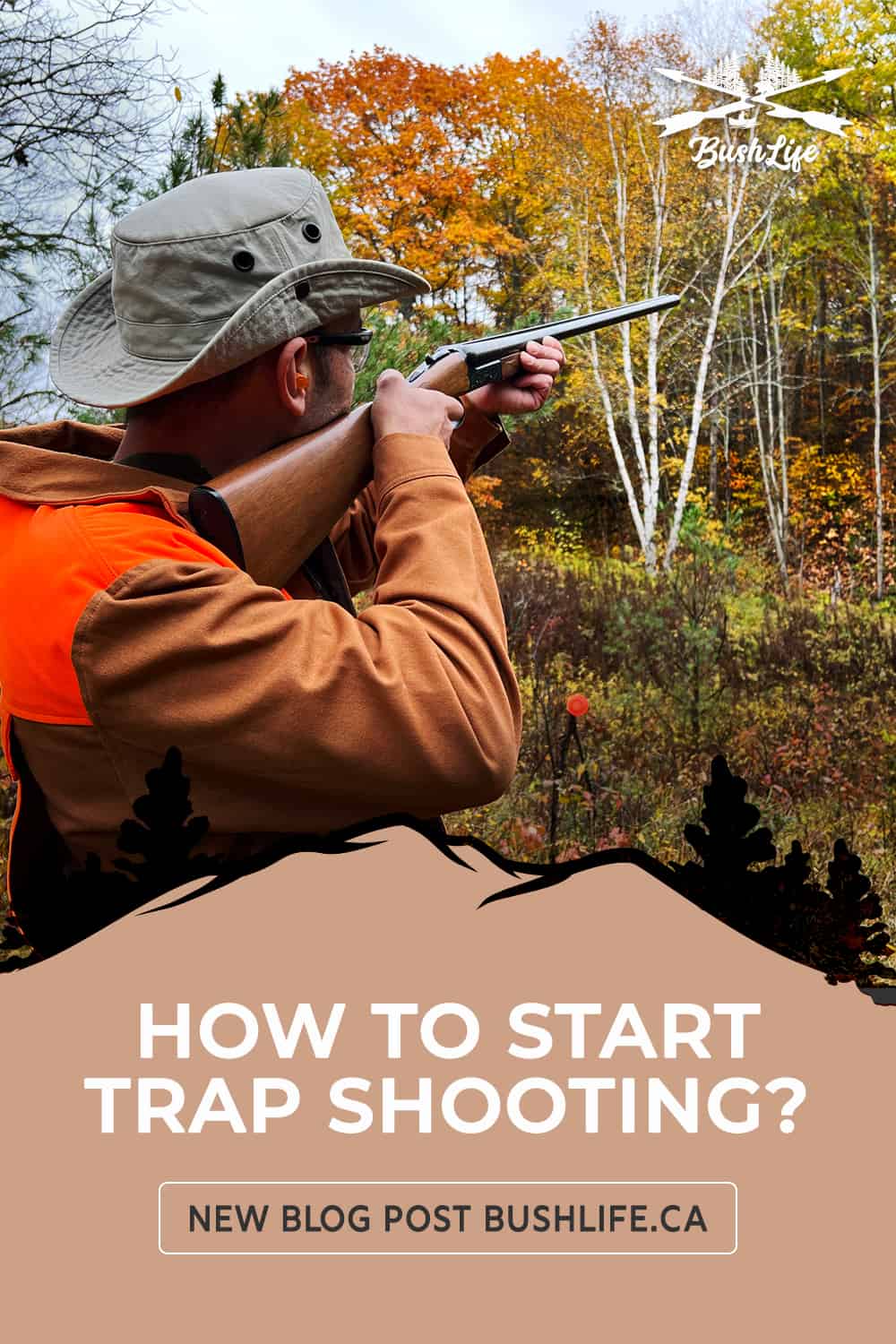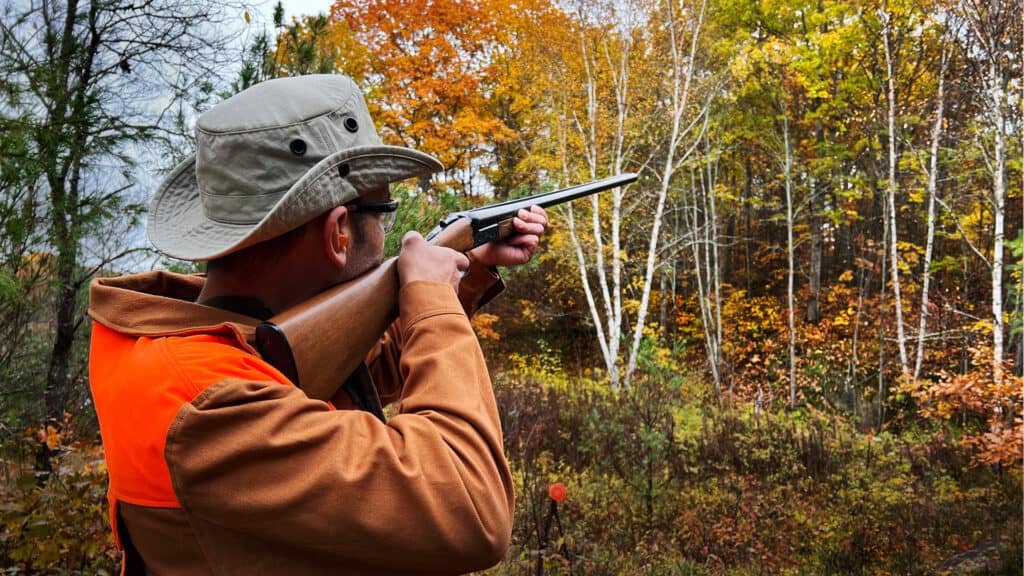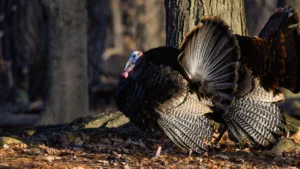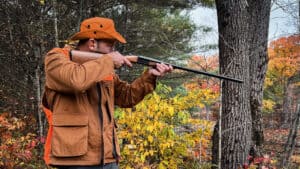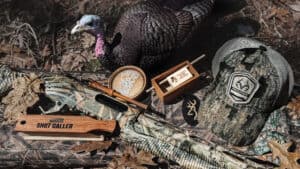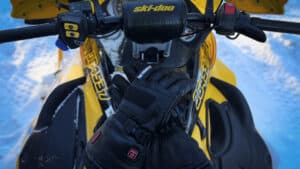Trap shooting is a BushLife favourite! Regardless of any stigma guns are getting, thanks to criminals and crazies, trap shooting is and always will be a classy sport enjoyed internationally, including the Olympics. Trap shooting is also the best practice you will ever get for hunting birds!
Discloure: Posts may contain affiliate links. Purchases made through our links result in a small commission to us at no charge to you. We only recommend products that meet our brand standards based on testing and first hand use by our authors.
What is Trap Shooting
While trap shooting is a competitive sport, and many professional trap shooters may have zero interest in hunting, that can’t be said for its roots. Trap shooting was invented as a form of hunting practice to shoot birds, real pigeons, to be exact. These pigeons were eventually replaced with clays.
Hence the term “clay pigeon.” I figured as much, but until one confirms these things in the history books, curiosity will always make you wonder how a round disk gets the name clay pigeon:)
The Three Disciplines of Shooting Clay Pigeons
Generally speaking, we loosely toss out the term trap shooting, and many of us have been there and done it. But that’s not always correct. We often end up either trap or skeet shooting. So, let’s look at the differences between trap shooting vs skeet vs sporting clays to understand what is involved, how it’s done, and why. And for the record, if you’ve heard the term “busting clays,” well you’re looking at it.
Trap Shooting
The trap house (clay-throwing machine) is positioned in front of the shooter. The clay typically flies AWAY from the shooter. The trick here is the longer the clay flies, the farther it becomes from the shooter. By the way, a shotgun typically has a spread of 1″ per yard of travel, and its pattern changes vastly over distance. It can also be tricky to guess the trajectory of the target.
Skeet Shooting
The best way to explain the difference between trap and skeet shooting is this: If you look straight ahead and imagine clay going away from you, that’s a trap. Skeet, on the other hand, will come from the side! Both sides to be exact. So, while the clays will still fly in front of you, their trajectory is more perpendicular to that of trap. The idea here is to hit both clays.
Again, it was a hunter who realized that the trap wasn’t good enough to prepare for birds. Birds fly more erratically and come from all directions, hence the development of skeet shooting.
Further Reading: A Guided Duck Hunt: The Easy Way to Learn Hunting
Sporting Clays
Now, sporting clays is something I honestly haven’t experienced. The shooter moves around a course, each station being unique. Here, clays will come from any direction. We can compare this discipline of clay shooting most easily to golf.
Should I Practice Trap Shooting or Skeet?
The most straightforward discipline and where to start is trap. Shooting is an art form, but the same holds for throwing clays.
When starting, let’s assume you’ll be out with a buddy throwing clays by a handheld target launcher. It’s simpler to be close to the shooter and send clays down range as in a trap. Ie. The person throwing stands just behind you and off to one side. Doing so keeps them safely behind the gun yet clear of the shooter so they have a clear line of sight to throw.
Compare this to skeet, where you would be throwing clays from the side and at a great distance from the shooter – with the intent to get the clays in front of the shooter! It requires a lot more skill.
Trap also removes the worry about over-swinging the shotgun and aiming at the person throwing the clay from the side. That shouldn’t be an issue for people with extensive firearms experience. But it’s certainly safer for anyone new to the sport.
I Trap Shoot with My Family for 3 Reasons:
- It is easier to control the non-shooters and position them all BEHIND the active shooter. Having an imaginary line NO ONE crosses is much easier to set up and control, especially if any youth are involved.
- Your family may not be into shooting trap the same way you are. But that doesn’t mean they won’t enjoy the occasional trap session! My family is not as accustomed to recoil. If they shoot, it’s short and sweet. But they LOVE throwing the clays!
- Where we shoot, there is a small clearing of land. Sending clays from the sides is difficult due to lack of space. It’s almost impossible in light of all the surrounding cover and slope. Trap shooting becomes more beneficial as it can be pulled off in tighter spaces and maybe your only choice.
Moving Up to Skeet
Skeet is what I do when shooting with my experienced shooting buddies. Except we do a modified skeet where the clays only come from one side. It’s more than good enough practice for bird hunting. Whoever throws from the side can control the distance the clay is from the shooter as it passes in front of them. The thrower also controls the height, speed and trajectory of the clays. Believe me when I say this format is good enough. If someone can repeatedly hit their targets, they are doing great!
Trap Shooting vs Skeet Shooting for Hunting
Do both!!! Trap is excellent practice for birds flying away from you. Or towards you, for that matter. There’s some lateral movement and a lot of height changes. Skeets will mimic when birds come in from the sides. With skeet shooting, your lead technique will be critical in getting a good shot. We’ll cover the lead further below.
Skeet Shooting Practice Session
Late this summer, my schedule and Richard’s from Highland Waterfowl finally happened to line up one day. We turned the cameras on, and since our shooting session was long overdue, we ended up getting a ton of footage of Richard’s ass. The good news is we scored 7 seconds of heaven in the clip below, which clearly shows how we practice this modified skeet we just covered. This system has prepared me for birds in ways I can’t describe.
Trap Shooting Guns

Trap Shooter holds a break-action shotgun to expose the breech
Some people will hate me for saying this, but the shotgun does NOT matter! Trap or skeet is correctly done with an over-under double-barrel shotgun.
A proper trap version of the over-under, which is super customizable can be insanely expensive. But a pro trap shooter isn’t reading this post, nor has any of my buddies ever shown up with an over-under!
You may only have one shotgun. If so, that’s fine. Just get out there and start working on your trap shooting technique! And if you hunt, take whichever shotgun you intend to hunt with and practice with that! Get used to how the gun swings, develop some muscle memory, learn how to cycle quickly (if it’s a pump) and so on. Also, get into the habit of immediately reloading after shooting! Your buddy throwing will always wait for you before throwing again. Developing speed is a good practice for hunting.
Further Reading: Remington 870 Custom: The Best Shotgun You’ll Ever Find!
What Do You Need to Trap Shoot?
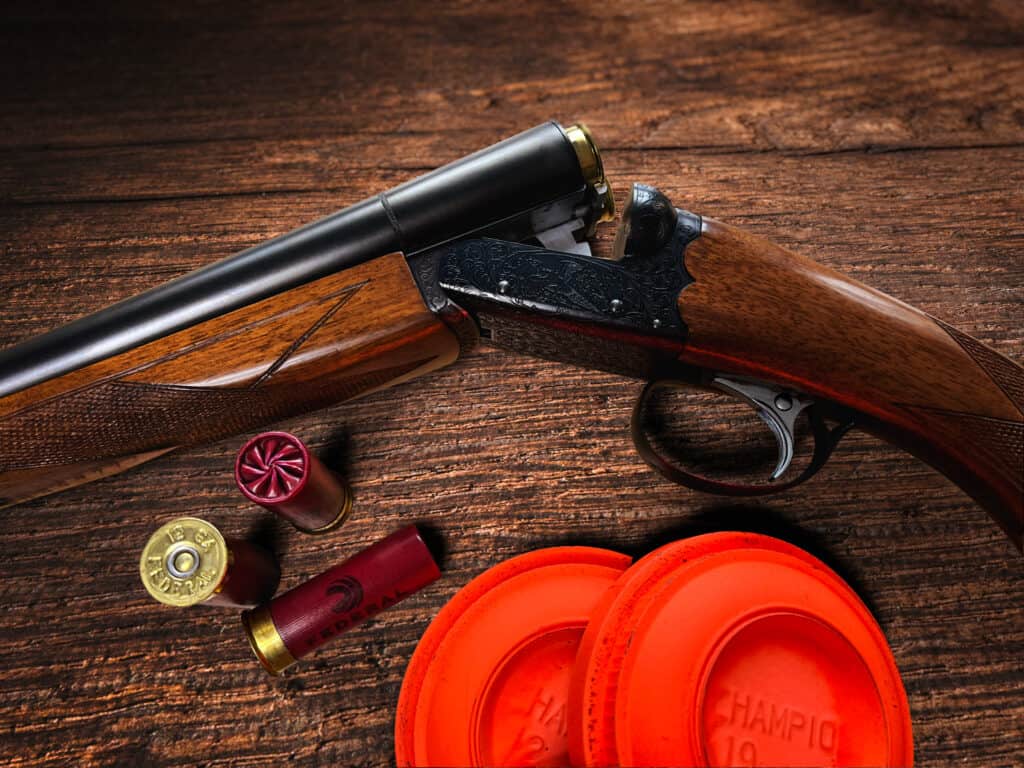
To start with trap shooting, you will need a shotgun, and 12 gauge is the gold standard. On the opposite end of the spectrum, a .410 technically works but is more difficult to hit. As you shoot a smaller gauge, the difficulty goes up. Professionally, there is no allowance given for shooting a smaller gauge.
You’ll also need a birdshot. Typically, this is a target load such as #7.5. You’ll have more pellets at your disposal and less recoil than with heavy or hunting loads. Trap shooting clubs will have specific ammo requirements. Do check ahead before your first trap shooting session.
Next comes the clay pigeons. My friends generally call these skeet – not 100% sure if it’s right or wrong. It is more comfortable to yell, “We are out of skeet,” nor have I heard someone say, “Bring the clay pigeons.” Simply calling them clays is another popular term. Clays come boxed in 135 pieces and usually cost around $25.
Lastly, you will need something to throw the clays. The handheld clay launchers are under $20!!! You don’t need a fancy machine – the electric trap thrower ranges anywhere from $70 to even $500. Throwing by hand is just as good, often better, as it mixes up the throws, and it’s harder for the shooter to guess trajectory.
Further Reading: Rifle Cleaning: Time Tested Techniques to Preserve Your Guns
How Do You Deal With Recoil?
The first time I went trap shooting, I put a LOT of rounds through a beautiful side-by-side double barrel and my old glory hunting shotgun. Ie. A beat-up 870 Wingmaster pump.
Both guns have a hard plastic plate on the buttstock, and neither has any features that absorb recoil! And, of course, it was a t-shirt (preferably no shirt) kind of hot day. It was also the day you get to see what happens when an old-school 12 gauge beats the crap out of you! I had the marks to prove it the next day.
You can readily get off more than 100 shots in a session, which can be hard on anyone new to shooting. As time goes by, you will get more accustomed to it. What never changes is the physical and mental demand, especially during longer sessions.
Don’t Forget to Mount!
It’s easy to get frustrated when new to trap or skeet shooting. There’s also a lot going on as you must mount the gun and get in the habit of swinging your shots. You also need to shoot ahead of the clay so that the shot and clay arrive together – this is that lead we keep referring to. It’s truly a form of art and comes with practice.
Here’s the thing – it doesn’t take much for you to forget to properly shoulder the shotgun when all these things are going on. It’s bad enough getting kicked by a 12 gauge 50-100 times – it’s a whole new level if you don’t shoulder the gun properly.
Get Some Padding
Butler Creek makes recoil pads for older guns with no recoil padding. It’s a $20-$30 slip-on piece that requires no gun alterations. Granted, it will extend the length of the pull a bit. You’ll have to figure out sizing by measuring the buttstock. From Butler Creek’s website, here is the sizing for the three various-sized pads.
Short of buying a new gun, this is the cheapest and quickest solution to help offset some of that recoil.
Trap Shooting Video
Yes, video! Up until now, we haven’t included lengthier videos in our posts. Elements of trap shooting are somewhat difficult to explain textually, so we recorded them below. Concepts such as lead are covered.
Taking Up Trap Shooting
This post is about casual trap or skeet shooting. While it hones in on a specific set of hunting skills, it is also insanely fun! Be warned, for some (especially if coordination is a challenge), it can be very frustrating at first – but that changes as you get over the hump.
It’s not hard to picture many people falling in love with trap shooting or skeet! Even those who have absolutely no desire to hunt. It’s also clear that it doesn’t take much to get started. If you live in the country, there’s a good chance you have enough land to trap shoot in your backyard.
If you find trap shooting is for you and you want to take it farther, it’s time to call your local trap club and hope they have an opening. There are trap shooting clubs everywhere, and there’s more to learn from experienced trap shooters. In many ways, it may be to learn things the right way than to develop bad habits that need fixing later. So, dust off that old shotgun and go bust some clays!
Thanks for reading my post and for your continuous support.
Bookmark this post on Pinterest for future reference!
